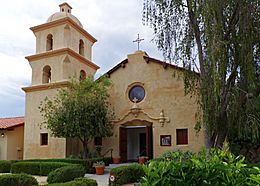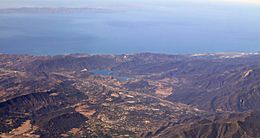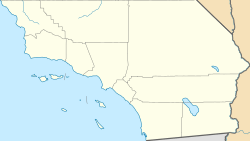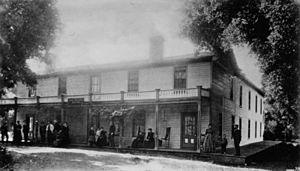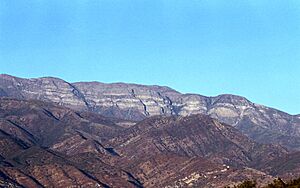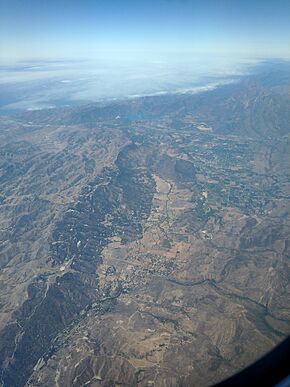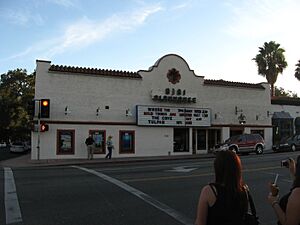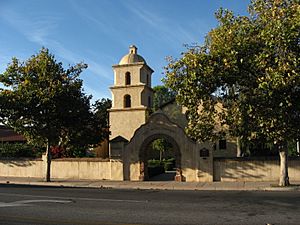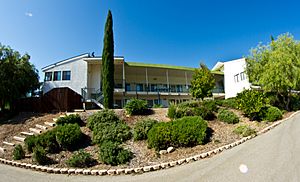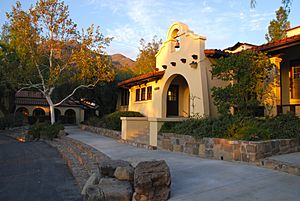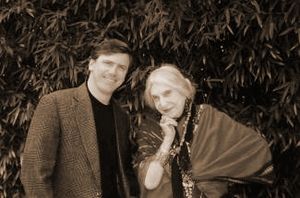Ojai, California facts for kids
Quick facts for kids
Ojai, California
|
|||
|---|---|---|---|
|
Top to bottom, left to right: Ojai Valley Museum; U.S. Post Office; Ojai Arcade; aerial view of Ojai
|
|||
|
|||
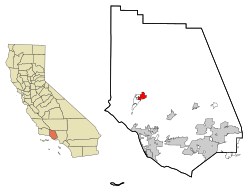
Location in Ventura County and the state of California
|
|||
| Country | |||
| State | |||
| County | Ventura | ||
| Incorporated | August 5, 1921 | ||
| Named for | Chumash: 'Awha'y ("Moon") | ||
| Government | |||
| • Type | City Council—City Manager | ||
| Area | |||
| • Total | 4.37 sq mi (11.32 km2) | ||
| • Land | 4.36 sq mi (11.28 km2) | ||
| • Water | 0.01 sq mi (0.04 km2) 0.35% | ||
| Elevation | 745 ft (227 m) | ||
| Population
(2020)
|
|||
| • Total | 7,637 | ||
| • Density | 1,747.6/sq mi (674.6/km2) | ||
| Time zone | UTC−8 (Pacific) | ||
| • Summer (DST) | UTC−7 (PDT) | ||
| ZIP Codes |
93023 & 93024
|
||
| Area code | 805 | ||
| FIPS code | 06-53476 | ||
| GNIS feature IDs | 1652763, 2411308 | ||

Ojai (pronounced OH-hy) is a city in Ventura County, California. It is located in the Ojai Valley, northwest of Los Angeles and east of Santa Barbara. The valley is about 10 kilometers (6 miles) long and 3 kilometers (2 miles) wide. It is surrounded by hills and mountains. In 2020, Ojai had a population of 7,637 people.
Ojai is known for its unique hotels, outdoor activities, hiking trails, and a farmers' market. This market sells fresh, local, and organic produce. The city has many small businesses that focus on local art, design, and eco-friendly home items. To help these small businesses and keep the town's special feel, large chain stores are not allowed in Ojai.
The name Ojai comes from the Chumash word ’Awhaỳ, which means "Moon." The city also calls itself "Shangri-La." This nickname refers to the beautiful natural surroundings. It also connects to the idea of a peaceful, hidden place, like the one in the 1937 movie Lost Horizon.
Contents
History of Ojai
Early History: The Chumash People
Ojai is on the traditional land of the Chumash. They were a Native American group who lived along the central and southern coast of California. Before European settlers arrived, over 10,000 Chumash people lived in more than 150 villages. They spoke different forms of the same language.
Starting in 1769, Spanish soldiers and missionaries came to California. They aimed to settle the coast and bring Christianity to the native people. The Chumash were moved from their villages to Spanish missions. Under Spanish rule, many Chumash people died from new diseases. By 1900, the Chumash population had dropped to only about 200 people. Today, there are between 2,000 and 5,000 Chumash people.
The name Ojai comes from the Chumash word ’awha'y, meaning "moon." Some older books from 1905 say the name means "nest," but the "moon" meaning is more widely accepted.
Rancho Ojai and Early Oil Exploration
In 1837, Fernando Tico, a businessman from Santa Barbara, received a large land grant called Rancho Ojai. This grant included both the lower and upper Ojai valleys. Tico raised cattle on the land.
Later, in 1864, Thomas A. Scott, a wealthy businessman from Pennsylvania, bought the rancho. People had found oil seeps (places where oil naturally comes out of the ground) in the Sulphur Mountain area. In 1866, Scott's nephew, Thomas Bard, used a drilling rig to search for oil. In 1867, they found oil, and the Ojai Field produced about 10-20 barrels of oil each day. Other people also dug oil tunnels. However, oil prices fell, and it became cheaper to import oil. So, Scott and others stopped looking for oil in the valley for a while. Thomas Bard later returned in the 1890s and dug many more oil tunnels.
Nordhoff: A Town for Health
The town was first planned in 1874 by R.G. Surdam. He named it Nordhoff, after the writer Charles Nordhoff. Nordhoff had written a book about California, saying it was a good place for health. Many early settlers came to the Ojai Valley because they or their family members were sick, especially with breathing problems. The valley became known for its healthy air. Charles Nordhoff visited the town named after him in the 1880s. The discovery of hot springs in Matilija Canyon also added to the valley's reputation as a healing place.
Today, the public junior high and high school in Ojai is called Nordhoff Junior High and High School.
The Railroad Arrives
In 1898, the Ventura and Ojai Valley Railroad connected Ojai to the main train lines near Ventura station. This made it easier for people and goods to travel to and from Ojai. However, in January 1969, heavy rains caused floods that destroyed the rail line. The old railway path was later turned into the Ojai Valley Trail in 1989. This trail is now used for walking and biking.
Edward Libbey and the Town's New Look
Nordhoff became a popular winter vacation spot for wealthy people from the East and Midwest. The fancy Foothills Hotel was built in 1903. Visitors enjoyed dining, music, horseback riding, and hunting. Some of these visitors built homes and helped the town grow.
One important visitor was Edward Drummond Libbey, who owned the Libbey Glass Company. He loved the valley and bought property in 1909. He built a beautiful house there. Libbey wanted to make the town even more beautiful. He bought properties on the south side of Ojai Avenue and tore down most of the old buildings.
In 1916, he hired architects to redesign Nordhoff. They changed the town center to a Spanish Colonial Revival style, which you can still see today. This project included a Spanish-style arcade (a covered walkway with arches) along the main street. It also had a bell-tower similar to a famous one in Havana, Cuba.
In March 1917, after the renovation was finished, the town's name was changed to Ojai. The valley had always been known as "The Ojai." The first "Ojai Day" celebration took place on April 7, 1917, to thank Libbey for his contributions. Ojai Day is still celebrated every October.
In 1917, two fires hit Ojai. One started in Matilija Canyon and burned many buildings, including the Foothills Hotel. The new Spanish-style buildings downtown were safe. Another fire started in a store in the Arcade, burning part of it. A new Foothills Hotel was built in 1919-1920.
Housing Development
The Taormina neighborhood became the first historic district in Ojai in 2016. It was built in the 1960s and 1970s by members of the Theosophy movement. Most homes in Ojai were built between 1940 and 1980. To control growth, a special rule was passed in the 1970s to slow down new construction.
Geography and Climate
Location and Mountains
Ojai is in a small valley that runs east to west. It is north of Ventura and east of Santa Barbara. The city is about 227 meters (745 feet) above sea level. It is next to the Los Padres National Forest to the north and about 24 kilometers (15 miles) from the Pacific Ocean.
The Ojai Valley is surrounded by the Topatopa Mountains to the north and Sulphur Mountain to the south. These mountains are part of the Transverse Ranges system. The area has many oak trees. The Sisar fault in the valley caused a magnitude 5.1 earthquake on August 20, 2023.
Rivers and Creeks
Creeks to the west of Ojai, like Coyote, Matilija, and Santa Ana creeks, flow into the Ventura River. Dams on these creeks, like Matilija Dam and Casitas Dam, change how the water flows. The Ventura River flows into the Pacific Ocean at the city of Ventura.
The eastern part of the Upper Ojai Valley is drained by the Sisar and Santa Paula creeks. These flow into the Santa Clara River. Sespe Creek, which is 88 kilometers (55 miles) long, flows into the Santa Clara River at Fillmore. In 1991, a large part of Sespe Creek was given "Wild & Scenic River" status. This protects its natural beauty.
Ojai's Climate
Ojai has a Mediterranean climate. This means it has hot, dry summers and mild, rainy winters. Summer temperatures can go above 38°C (100°F). Winter nights can sometimes drop below freezing. The coldest temperature ever recorded was -10.6°C (13°F) in January 1913. The hottest was 48.3°C (119°F) in June 1917.
Most of the rain falls between October and April. When it rains, it can be very heavy. For example, on February 24, 1913, 23 centimeters (9.05 inches) of rain fell in one day. The wettest month ever was January 1969, with 65.4 centimeters (25.76 inches) of rain. However, Ojai can also have very dry years. The average yearly rainfall is about 46 centimeters (18.1 inches).
| Climate data for Ojai, California, 1991–2020 normals, extremes 1905–present | |||||||||||||
|---|---|---|---|---|---|---|---|---|---|---|---|---|---|
| Month | Jan | Feb | Mar | Apr | May | Jun | Jul | Aug | Sep | Oct | Nov | Dec | Year |
| Record high °F (°C) | 91 (33) |
92 (33) |
98 (37) |
104 (40) |
105 (41) |
119 (48) |
117 (47) |
115 (46) |
117 (47) |
109 (43) |
100 (38) |
94 (34) |
119 (48) |
| Mean maximum °F (°C) | 81.3 (27.4) |
81.8 (27.7) |
85.9 (29.9) |
92.5 (33.6) |
94.5 (34.7) |
98.0 (36.7) |
102.4 (39.1) |
104.5 (40.3) |
104.1 (40.1) |
98.5 (36.9) |
89.1 (31.7) |
80.2 (26.8) |
107.1 (41.7) |
| Mean daily maximum °F (°C) | 66.0 (18.9) |
66.9 (19.4) |
69.8 (21.0) |
74.0 (23.3) |
77.4 (25.2) |
82.1 (27.8) |
88.8 (31.6) |
91.2 (32.9) |
88.2 (31.2) |
80.9 (27.2) |
72.7 (22.6) |
65.3 (18.5) |
76.9 (24.9) |
| Daily mean °F (°C) | 50.2 (10.1) |
51.3 (10.7) |
54.3 (12.4) |
57.6 (14.2) |
61.7 (16.5) |
65.9 (18.8) |
71.5 (21.9) |
72.4 (22.4) |
69.7 (20.9) |
62.9 (17.2) |
55.0 (12.8) |
49.3 (9.6) |
60.2 (15.7) |
| Mean daily minimum °F (°C) | 34.5 (1.4) |
35.8 (2.1) |
38.7 (3.7) |
41.2 (5.1) |
46.0 (7.8) |
49.7 (9.8) |
54.1 (12.3) |
53.5 (11.9) |
51.1 (10.6) |
44.9 (7.2) |
37.4 (3.0) |
33.2 (0.7) |
43.3 (6.3) |
| Mean minimum °F (°C) | 27.2 (−2.7) |
29.3 (−1.5) |
31.9 (−0.1) |
35.0 (1.7) |
40.4 (4.7) |
44.6 (7.0) |
49.0 (9.4) |
48.2 (9.0) |
44.6 (7.0) |
38.4 (3.6) |
30.9 (−0.6) |
26.4 (−3.1) |
25.2 (−3.8) |
| Record low °F (°C) | 13 (−11) |
21 (−6) |
25 (−4) |
27 (−3) |
31 (−1) |
34 (1) |
40 (4) |
39 (4) |
37 (3) |
25 (−4) |
23 (−5) |
16 (−9) |
13 (−11) |
| Average precipitation inches (mm) | 5.09 (129) |
5.24 (133) |
3.41 (87) |
1.08 (27) |
0.54 (14) |
0.11 (2.8) |
0.07 (1.8) |
0.00 (0.00) |
0.10 (2.5) |
0.84 (21) |
1.32 (34) |
2.88 (73) |
20.68 (525.1) |
| Average snowfall inches (cm) | 0.0 (0.0) |
0.0 (0.0) |
0.1 (0.25) |
0.0 (0.0) |
0.0 (0.0) |
0.0 (0.0) |
0.0 (0.0) |
0.0 (0.0) |
0.0 (0.0) |
0.0 (0.0) |
0.0 (0.0) |
0.0 (0.0) |
0.1 (0.25) |
| Average precipitation days (≥ 0.01 in) | 6.8 | 8.0 | 7.1 | 4.0 | 2.7 | 1.0 | 0.5 | 0.0 | 0.5 | 2.7 | 4.1 | 6.8 | 44.2 |
| Average snowy days (≥ 0.1 in) | 0.0 | 0.0 | 0.2 | 0.0 | 0.0 | 0.0 | 0.0 | 0.0 | 0.0 | 0.0 | 0.0 | 0.0 | 0.2 |
| Source 1: NOAA | |||||||||||||
| Source 2: National Weather Service | |||||||||||||
People and Economy
Population Changes
| Historical population | |||
|---|---|---|---|
| Census | Pop. | %± | |
| 1930 | 1,468 | — | |
| 1940 | 1,622 | 10.5% | |
| 1950 | 2,519 | 55.3% | |
| 1960 | 4,495 | 78.4% | |
| 1970 | 5,591 | 24.4% | |
| 1980 | 6,816 | 21.9% | |
| 1990 | 7,613 | 11.7% | |
| 2000 | 7,862 | 3.3% | |
| 2010 | 7,461 | −5.1% | |
| 2020 | 7,637 | 2.4% | |
| U.S. Decennial Census | |||
In 2010, Ojai had 7,461 people. Most residents (87.9%) were White. About 17.9% of the population was Hispanic or Latino. The average age in Ojai was 47.1 years old. Many people (56.9%) owned their homes, while others (40.7%) rented.
In 2000, Ojai had 7,862 people. The population density was about 684 people per square kilometer (1,773 people per square mile). The median income for families was $52,917. About 10.7% of the population lived below the poverty line.
Ojai's Economy
Ojai is a popular place for tourists. It has unique hotels, outdoor activities, hiking, and a farmers' market. The Ojai Valley Inn, which opened in 1923, is a large resort with a golf course.
The city has many small businesses. These businesses focus on local art, design, and eco-friendly home products. To help these local businesses, Ojai has a rule that prevents large Chain stores from opening in the city. This helps keep the town's special character.
Arts and Culture in Ojai

Ojai's culture is all about nature, health, and local art. People enjoy walking and hiking. You might see classic cars or motorcycle clubs touring the area on weekends.
The Ojai Music Festival started in 1947. It is an annual event where famous musicians and composers perform. It happens on the first weekend after Memorial Day. Famous artists like Igor Stravinsky and Pierre Boulez have been part of the festival.
Bart's Books, an outdoor bookstore, has been in Ojai since 1964. It is well-known and has been featured in news stories. Ojai also hosts the annual Ojai Playwrights Conference. This event brings professional writers and actors to the city.
The local newspaper is the Ojai Valley News. There are also magazines like the Ojai Valley Guide and the Ojai Quarterly. In early June, the Ojai Wine Festival is held at Lake Casitas. Over 3,000 wine lovers try wines from many different wineries. The money raised goes to charity.
Parks and Recreation
Ojai and its surrounding areas offer many fun outdoor activities. The Los Padres National Forest is just north of town. You can access many areas in the forest from Highway 33. Matilija Creek is a great spot for splashing under waterfalls and backpacking. To the west, the Lake Casitas Recreation Area has camping, picnics, hiking, boating, and fishing. It also has a water park.
The town has public tennis courts in Libbey Park downtown. There are also two main golf courses: Soule Park Golf Course and Ojai Valley Inn Golf Course. In 2002, the town opened a new park called Cluff Vista Park. It has different areas with California native plants, water features, and public art. The park is on a small hill with views of the mountains.
Sarzotti Park is a 4-hectare (10-acre) city park. It is home to the City of Ojai Recreation Center. This center offers sports like soccer, softball, football, basketball, tennis, and volleyball. It also has exercise programs and other classes.
Every April, Ojai hosts the Ojai Tennis Tournament. It is the oldest tennis tournament west of the Mississippi River, started in 1896. Many famous tennis players have competed here. The Wall of Fame in Libbey Park honors players who won major titles after competing in Ojai.
Ventura County also has parks nearby, such as Foster Park, Camp Comfort, and Dennison Park. In early April, Ojai hosts a bicycle race called the "Garrett Lemire Memorial Grand Prix." It honors a young cyclist from Ojai who passed away. The race brings professional and amateur teams from all over the country.
Education in Ojai
Public Schools
The Ojai Unified School District serves the public schools in Ojai. These include:
- Chaparral High School
- Nordhoff Junior High and High School
- Meiners Oaks Early Education School
- Mira Monte Elementary School
- Summit School
- Topa Topa Elementary School
Other Schools
The Ojai Valley is also home to several private schools and other learning programs:
- Besant Hill School of Happy Valley
- The Thacher School
- Ojai Valley School
- Villanova Preparatory School
- Oak Grove School
- Weil Tennis Academy
- Monica Ros School (preschool through 3rd grade)
- The Montessori School of Ojai
- Valley Oak Charter School (a K-12 public homeschool hybrid)
- Laurel Springs School (distance learning and homeschooling)
- Rock Tree Sky (a self-directed learning community)
- Global Village School (a homeschool and private school hybrid)
- Camp Ramah in California (a Jewish summer camp)
Media in Ojai
The Ojai Valley News is a weekly newspaper that covers local news. It has been published since 1891. Over the years, it has gone through different names and mergers with other local papers.
City Services
Utilities
In 2013, Ojai voters approved a plan to take over the private water system. Casitas Municipal Water District now manages Ojai's water system. The Ojai Valley Sanitary District handles the city's sewage treatment. In 2020, the city decided to ban new natural gas connections for most buildings, except for restaurants and pools.
Libraries
The Ventura County Library system has three branches in the Ojai Valley:
- Ojai Library
- Oak View Library
- Meiners Oaks Library
Transportation
The City of Ojai has its own Ojai Trolley bus system. Gold Coast Transit also connects Ojai to Ventura.
Famous People from Ojai
- Bud Abbott, actor and comedian
- David Allen, author of Getting Things Done
- June Allyson, actress
- Sergio Aragonés, cartoonist
- Alan Ball, film and TV writer
- Ed Begley Jr., actor
- Elmer Bernstein, film composer
- Jon Bernthal, actor
- Tim Burton, film director
- Rory Calhoun, actor
- Julie Christie, Oscar-winning actress
- Ted Danson, actor
- Donald Glover, actor and musician
- Larry Hagman, actor in I Dream of Jeannie and Dallas
- Anne Heche, actress
- Richard Jefferson, molecular biologist
- John Krasinski, actor
- Jiddu Krishnamurti, philosopher
- Diane Ladd, actress
- Zachary Levi, actor in Chuck
- Ted Levine, actor in The Silence of the Lambs
- Lissie, singer/songwriter
- Malcolm McDowell, actor
- Bill Paxton, actor in Aliens
- Anthony Quinn, actor
- Betsy Randle, actress, Boy Meets World
- Rick Rossovich, actor in Top Gun
- Peter Scolari, actor
- Mary Steenburgen, actress
- Peter Strauss, actor
- Reese Witherspoon, Oscar-winning actress
- Beatrice Wood, artist
- Loretta Young, actress
- Chloé Zhao, Oscar-winning film director
See also
 In Spanish: Ojai para niños
In Spanish: Ojai para niños


